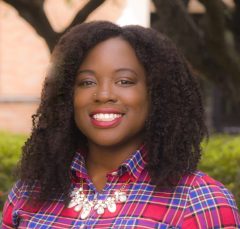TDL Member Profile: Peace Ossom Williamson
The September/October TDL Member Profile features Peace Ossom Williamson, Director for Research Data Services at the University of Texas at Arlington. Below is the full member profile with background information and a question and answer session with Peace.
Background
Education
- 2013: Master of Science in Health Studies, Texas Woman’s University
- 2013: Master of Library Science, Texas Woman’s University
- 2010: Bachelor of Arts, Psychology, University of Oklahoma
Professional Experience
- July 2016 – present: Director for Research Data Services, The University of Texas at Arlington Libraries
- Developing library services and partnerships across campus around data management and data visualization. Also, serving as liaison in support of research within the College of Nursing and Health Innovation.
- December 2014 – October 2015: Interim FabLab Co-Manager, The University of Texas at Arlington Libraries
- Planned a multi-part renovation in development of an 8,000 ft2 makerspace, including developing programs and services, incorporating assessment, and training and managing staff, and was awarded grants and wrote funding proposals.
- December 2013 – December 2014: Health Sciences Librarian, The University of Texas at Arlington Libraries
- Served as primary liaison to students and faculty of the College of Nursing and Health Innovation, the Department of Biology, and the Department of Psychology.
- October 2012 – December 2013: Cataloger & Technical Services Assistant, Baylor Health Sciences Library
- Input new materials in the library catalog and original cataloged materials from the History of Dentistry Collection. Led the deselection, replacement, and repair of materials to maintain current collection and managed library’s holdings.
Professional Affiliations
- HealthLINE (2012-present, current Chair-Elect)
- Texas Library Association (2013-present, 2017 Conference Program Committee)
- South Central Chapter, Medical Library Association (2011 – present, HLIS Secretary, Credentialing Committee)
- Medical Library Association (2011 – present, Education Planning Workgroup)
- Association for Information Science and Technology (ASIS&T)
Select Publications
- Offor, N., Ossom Williamson, P., & Cacola, P. (forthcoming). Effectiveness of interventions for children with developmental coordination disorder in physical therapy contexts: A systematic literature review and meta-analysis. Journal of Motor Learning and Development.
- Mirza, R., Currier, B. D., & Ossom Williamson, P. (2016). Memorandum of understanding workbook. Available via https://uta-ir.tdl.org/uta-ir/handle/10106/25646/
- Ossom Williamson, P. & Scott, J. (2016). Technology: 3D printing in medical libraries. MLA News, 56(4), 23.
- Ossom Williamson, P. & Mirza, R. (2015). Does Google Scholar help or hurt institutional repositories? In C. Smallwood (Ed.), The complete guide to using Google in libraries: instruction, administration, and staff productivity. Lanham, MD: Rowman & Littlefield.
- Williamson, P. O. (2015). Improving interaction in online liaison services through Skype. International Journal of Digital Library Systems, 5(1), 45-64.
Select Credit-Baring Courses and CEs:
- KINE 3351: Public Health Informatics – UTA Department of Kinesiology semester course, 3 hours.
- Exploring community data: Using Tableau Public for data analysis – Medical Library Association, 6 CE hours.
- Fostering innovation and incorporating emerging technologies into academic nursing education activities – American Nurses Credentialing Center, 2.5 CNE hours.
- Applications of maker technologies for the medical librarian – Medical Library Association, 4 CE hours.
Select Presentations
- Ossom Williamson, P., Anderson, P., Helms, M., & Fowler, S. Advancing medical innovation: Biofabrication and medical device prototyping in libraries. Special content session presented at Mosaic 2016, Toronto, ON, CA.
- Mirza, R., Ossom Williamson, P., & Currier, B. D. Creating and utilizing memorandums of understanding (MOUs). Webinar presented for the Association of College and Research Libraries Digital Curation Interest Group.
- Ossom Williamson, P., & Trkay, G. Data literacy for all! Adapting data information literacy competencies for undergraduate instruction. Presented at LIRT Summit in Dallas, TX.
Involvement with TDL
- Data Literacy webinars planned for January 2017.
Questions and Answer
1) Why did you choose to work in libraries?
I was a work-study student at a law library for four years, and was looking into a role in the area of health sciences. After graduation, I worked in a public library and realized how I enjoyed both libraries and decided I wanted to combine my passion for libraries and health sciences in one career.
2) What projects or initiatives are you most excited about at your library?
I am most excited about our work in developing out research data services. We have a new Division of Scholarly Communication encompassing a large percentage of the library, now focused on unique collections; open access, open education, and open publishing; and digital scholarship. My role in research data services falls within this division, and we are looking to integrate the Libraries in all parts of the informaiton transfer cycle.
With my role centering on the creation of data management and visualization services and with the creation of dedicated lines focused on data analysis services and spatial data services, the campus has quickly begun integrating these new roles into their processes in instruction and research (and we haven’t even begun any major marketing efforts yet). Partnerships are quickly developing, and UTA Libraries is looking to invest further into long-term storage and preservation solutions for data and space options for data services and digital scholarship.
3. What is your most memorable TDL experience?
I have recently begun working with TDL staff since I just changed positions this year. However, I have been grateful for their quick welcome. TDL staff have reached out and began talks and plans, allowing me to quickly integrate with the state-wide work they’ve been leaders in accomplishing. I am very excited to progress in working with TDL and attending next year’s TCDL and the TDL Data Symposium.
